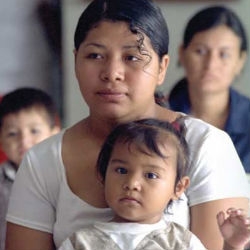
The report found a slight increase in the total share of all U.S. mothers who stay at home with their children, according to 2012 data. While a majority of all mothers work outside the home for pay, 29 percent stay home, an increase since 1999, when 23 percent did so.
But in a closer examination of the numbers, Hispanic women stood out as being especially likely to be at home, and this was even more pronounced among Hispanic immigrants, 44 percent of whom are not working outside the home. Among Asian mothers 36 percent are stay-at-home moms, but just one-fourth of black and white moms fit that category.
So, why do Hispanic moms stand out? One factor might be related to attitudes about what's best for children. Hispanics in general are far more likely than non-Hispanic whites or blacks to say that children are better off when a parent stays home to focus on the family. Fully 73 percent say as much, compared with 57 percent of whites and of blacks.
Views among Hispanics born in the U.S. mirror those of all Americans—about six-in-ten believe that kids are better off if a parent stays home to focus on the family, according to a 2014 Pew Research Center survey. But a far larger majority—85 percent–of foreign-born Hispanics say that children are better off if a parent is at home.
Differences in educational attainment might also help to explain why Hispanics born in the U.S. are less likely to be stay-at-home moms than those born elsewhere are. More education is associated with a much higher likelihood of working outside the home among mothers, perhaps due to the fact that those with higher education are more likely to be able to find work that pays enough to justify the cost of child care. Just 58 percent of foreign-born mothers have at least a high school diploma, compared with 84 percent of Hispanic mothers born in the U.S.
Among Hispanic stay-at-home moms, the demographic profiles of native-born and foreign-born moms are quite different. Fully three-quarters of foreign-born stay-at-home mothers are married, with a working husband. In comparison, just more than half (56%) of native-born stay-at-home moms fit this category. Instead, a relatively large share—30%—are single moms, as compared with just 13 percent of foreign-born stay-at-home moms.
As is the case among all mothers, among all Hispanic mothers, it is the stay-at-home moms who are less financially well-off than the working moms. Among the native born, 42 percent of at-home moms are living below the poverty line, as are 16 percent of working moms. And among the foreign born, the share living below the poverty line is 47 percent among stay-at-home moms, and 23 percent among working mothers.
Source: Pew Research Center, Among Hispanics, immigrants more likely to be stay-at-home moms and to believe that's best for kids, April 24, 1914.